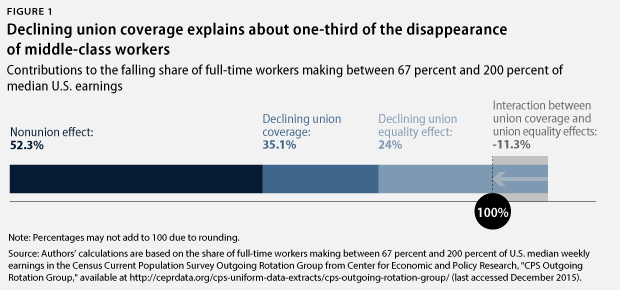The United States has long called itself a middle-class nation. But that statement is less true today than it was 30 years ago.
The most widely used barometer of the financial health of the middle class—real median household income as published by the U.S. Census Bureau—has barely grown over the last thirty years. At the same time, the middle class has been hollowed out as incomes have polarized, with more households at the top and the bottom and fewer in the middle of the income distribution. A recent report by the Pew Research Center showed that the share of adults in the middle class—defined as adults whose households make between 67 percent and 200 percent of median U.S. income—fell from 61 percent in 1971 to just 50 percent in 2014.
Unsurprisingly, the same trends of slow growth and rapid polarization are also found in the main source of middle-class income: wage and salary earnings. Median weekly earnings of full-time workers grew 18 percent between 1984 and 2014 despite a 79 percent increase in labor productivity in the United States. As with the income distribution, the earnings distribution has polarized: the share of full-time workers who make between 67 percent and 200 percent of median U.S. earnings fell from 68 percent in 1984 to 60 percent in 2014.
This report examines the role that the decline of labor unions over the past 30 years has played in the hollowing out of the U.S. earnings distribution. We* expect that the decline of unions has reduced the share of middle-class workers because union workers are more likely to be middle class than nonunion workers. Unions represent workers in the middle of the income distribution, which raises the earnings of workers who would otherwise fall below the middle-class threshold. We call the higher share of union workers among middle-class workers the union equality effect.
In this report, we use a technique—known as a shift-share decomposition—that breaks down the falling share of middle-class workers into three factors associated with unionism:
- The first part is due to the decline in union coverage, namely the fact that when a smaller share of workers are in unions, fewer workers benefit from the union equality effect.
- The second part is due to a decline in the union equality effect. As earnings have polarized over the past 30 years, the middle-class share of union workers fell from 83 percent to 72 percent, which is more than the decrease in the share of nonunion workers in the middle class. This reduces the union equality effect.
- The third part is associated with the interaction between the decline in union coverage and the union equality effect.
The decomposition leaves a residual part with no direct connection to unionism that is instead due to the decline in the middle-class share of nonunion workers.
Our main findings are that the decline in union coverage accounts for 35 percent of the falling share of middle-class workers and that the combination of the shrinking share of union workers and the reduction in the union equality effect explains almost half of the decline in middle-class workers. To the extent that union-induced wage increases spill over from union to nonunion workers and that union advocacy produces economic and social policies that benefit the middle class, our results understate the impact of the weakening labor movement on the hollowing out of the U.S. middle class.

Making America a middle-class country once again will require policies that raise median earnings and incomes and that bring more workers and households into the middle class. Increasing union coverage is important for both, as well as for possibly increasing economic mobility. For more on this topic, see the companion report, “What Do Unions Do for Mobility?”
* All references to “we,” “us,” and “our” refer to the authors of this report.
Richard Freeman holds the Herbert Ascherman chair in economics at Harvard University and is a research associate at the National Bureau of Economic Research. Eunice Han is a visiting professor of economics at Wellesley College and a senior research associate at the Labor and Worklife Program at Harvard Law School. Brendan V. Duke is a Policy Analyst for the Center for American Progress’ Middle-Out Economics project. David Madland is a Senior Fellow and the Strategic Director of the American Worker Project at the Center for American Progress.